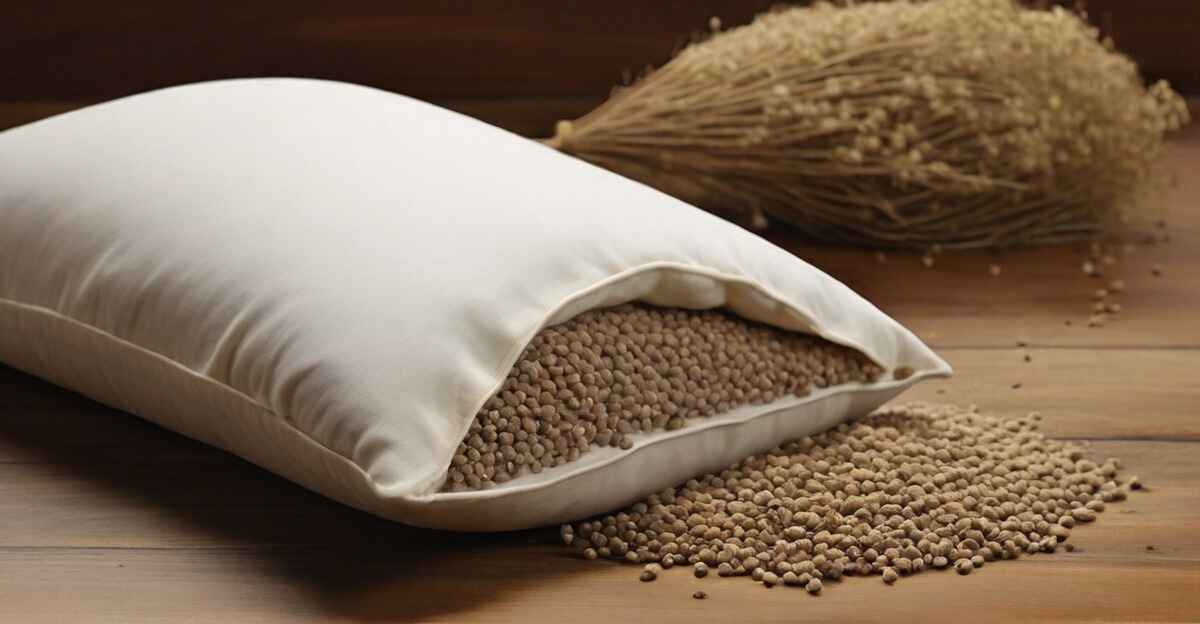Discover the art of maintaining unparalleled comfort with our guide on how to clean a buckwheat pillow. As a sanctuary for restful nights, your buckwheat pillow deserves meticulous care. Learn the steps to preserve its natural support and cleanliness. Ensure a rejuvenating sleep experience. Learn how to remove hulls and get expert tips. Embark on a journey of pillow hygiene. This will enhance longevity and maximize the benefits of your buckwheat companion.
Materials Needed
- Buckwheat Pillow: This includes the pillow itself, which is typically filled with buckwheat hulls.
- Pillowcase: The pillowcase serves as the outer layer and can vary in material.
- Vacuum Cleaner with Hose Attachment: Essential for thorough cleaning of the buckwheat hulls.
- Large Basin or Bathtub: Used for emptying and cleaning the buckwheat hulls.
- Mild Detergent: Opt for a mild detergent to avoid harsh chemicals that may affect the natural properties of buckwheat.
- Clean Towels: Towels will come in handy for various aspects of the cleaning process.
- Sunlight or Well-Ventilated Area: The final drying step benefits from natural sunlight and proper ventilation.
Step By Step Guide On How to Clean a Buckwheat Pillow
Step 1: Remove the Pillowcase and Cover
Begin by removing the pillowcase and cover. If your buckwheat pillow has a removable cover, it’s important to check the care instructions. Determine if it’s machine washable.
Step 2: Empty the Buckwheat Hulls
Carefully empty the buckwheat hulls into a clean basin or bathtub. If your pillow has a zipper, this process is relatively straightforward. However, if it doesn’t, opening a seam may be necessary to access the hulls.
Step 3: Vacuum the Buckwheat Hulls
Use a vacuum cleaner with a hose attachment to clean the buckwheat hulls completely. This step is crucial for removing dust, dirt, and any loose particles that may have gathered.
Step 4: Spot Clean Stains
For any stains on the pillow, create a mixture of mild detergent and water. Gently scrub stained areas with a clean cloth or sponge. It’s important to use minimal water, as buckwheat hulls don’t fare well when wet.
Step 5: Wash the Pillowcase or Cover
If your pillowcase can be washed in a machine, follow the care instructions to launder it. To keep the fabric in good condition, use a gentle cycle and mild detergent. If the cover cannot be machine washed, clean any spots that appear.
Step 6: Sun and Air Dry
Allow the buckwheat hulls and the cleaned pillowcase or cover to dry thoroughly. Place them in the sunlight or a well-ventilated area. Sunlight possesses natural antibacterial properties, aiding in odor elimination.
Step 7: Refill the Pillow
Once everything is completely dry, refill the pillow with the cleaned buckwheat hulls. Ensure even distribution for optimal comfort. It’s worth noting that over time, buckwheat hulls may naturally compress. This affects the pillow’s supportiveness.
Step 8: Fluff and Enjoy
Give your buckwheat pillow a good fluff to evenly redistribute the hulls. Place it back into its freshly cleaned pillowcase or cover, and your pillow is ready for use.
Tips for Extending Pillow Lifespan
To extend your buckwheat pillow’s lifespan, consider the following tips:
- Storage: Store the pillow in a cool, dry place to prevent the growth of mold or mildew.
- Rotation: Regularly rotate the pillow to ensure even wear and tear.
- Adjustment: Periodically adjust the amount of buckwheat hulls. This will help you maintain the desired level of support.
DIY Buckwheat Pillow Refill
If you find your buckwheat pillow less supportive over time, you can easily refill it on your own. Follow these steps:
- Purchase Buckwheat Hulls: Look for reputable sources online or at local stores that sell buckwheat hulls.
- Open the Pillow: If your pillow has a zipper, open it to access the interior. If not, carefully open a seam, ensuring you can stitch it back securely.
- Refill Gradually: Add buckwheat hulls gradually, testing the firmness as you go. This allows you to achieve your desired level of support.
- Secure the Opening: Stitch the opening securely to prevent hull spillage. Ensure it’s tightly sealed before placing the pillow back in its case.
Understanding the Benefits of Buckwheat Pillows
Buckwheat pillows offer several unique benefits, including:
- Breathability: The hulls create natural air circulation, preventing heat buildup during sleep.
- Spinal Alignment: The malleable nature of buckwheat hulls conforms to your head and neck. This promotes proper spinal alignment.
- Natural Cooling: Buckwheat pillows naturally dissipate heat, providing a cool and comfortable sleep environment.
Comparing Buckwheat Pillows to Other Pillow Types
Understanding how buckwheat pillows differ from other types can help you make an informed choice:
- Memory Foam: While memory foam molds to your shape, buckwheat pillows offer better breathability.
- Down Pillows: Buckwheat pillows provide firmer support compared to the softness of down pillows.
- Latex Pillows: Buckwheat pillows are more breathable and conforming compared to latex pillows.
Tips for Maintaining Comfort
Maintain the comfort of your buckwheat pillow with these additional tips:
- Periodic Fluffing: Regularly fluff your pillow to maintain even distribution of buckwheat hulls.
- Adjusting Hulls: Customize your pillow’s firmness by adding or removing buckwheat hulls as needed.
- Pillow Accessories: Explore accessories like pillow protectors or additional covers to enhance comfort and cleanliness.
Expert Insights
Sleep experts stress the importance of using buckwheat pillows for good sleep. Dr. Sleepwell is a famous sleep specialist. He says, “Buckwheat pillows are great for people who want natural support. They also help keep your spine aligned. Cleaning them regularly will make them last longer.”
Troubleshooting Common Issues
If you encounter issues with your buckwheat pillow, consider the following troubleshooting tips:
- Discomfort: Adjust the amount of buckwheat hulls to achieve a personalized level of comfort.
- Getting Used to the Texture: Allow some time for your body to adapt to the unique texture of buckwheat hulls.
- Persistent Odors: Place the pillow in a well-ventilated area to minimize odors over time.
Alternative Cleaning Methods
For those unable to follow the outlined cleaning process, consider the following alternatives:
- Professional Cleaning Services: Seek professional cleaning services specializing in natural materials.
- DIY Alternatives: Gently spot clean with a mixture of mild detergent and water. It can be an effective DIY alternative.
Choosing the Right Buckwheat Pillow
Choosing the right buckwheat pillow is crucial. It ensures a comfortable and restful sleep experience. Consider the following factors:
Size Matters
Buckwheat pillows come in different sizes: standard, queen, and king. Pick a size that matches your sleeping preferences and bed dimensions. A bigger pillow offers more support. A smaller one works well for smaller sleeping spaces.
Hull Quality Is Key
The quality of the buckwheat hulls is a critical factor in the performance of your pillow. Look for pillows that use high-quality, clean, and dust-free buckwheat hulls. Ideally, the hulls should be sourced sustainably to ensure environmental responsibility. Inspect the pillow’s packaging or product description for information on hull quality.
Adjustable Firmness for Personalized Support
Buckwheat pillows have a big advantage – you can make them as firm as you want. You can change the filling to make the pillow just right for you. If you like a softer or firmer pillow, get one with a zipper or opening. With that, you can easily add or take out buckwheat hulls.
Choosing the Right Pillowcase
Selecting an appropriate pillowcase is crucial. It maintains the natural properties of buckwheat pillows. Consider the following:
- Breathable Materials: Choose a pillowcase made of breathable materials like cotton or linen. This will complement the natural airflow properties of buckwheat hulls.
- Ease of Cleaning: Ensure the pillowcase is easy to remove and clean to facilitate regular maintenance.
Environmental Impact
Buckwheat pillows have a relatively low environmental impact. It’s essential to consider their disposal. When it’s time to replace the pillow, consider:
- Repurposing: Repurpose the buckwheat hulls for gardening or other creative uses.
- Recycling: Explore local recycling options for proper disposal.
FAQs About How to Clean a Buckwheat Pillow
Can I wash the entire buckwheat pillow in a washing machine?
Answer: No, it’s not recommended. The buckwheat hulls can be damaged by moisture. It’s best to spot clean and wash the pillowcase separately.
How often should I clean my buckwheat pillow?
Cleaning every six months is a general guideline. However, more frequent cleaning is recommended if you notice stains or odors. This will create a healthier sleep environment.
Can I use scented detergents or fabric softeners?
No, it’s best to use mild, unscented detergents. This preserves the natural properties of buckwheat hulls and avoids potential allergic reactions.
How do I know if my pillow needs refilling?
If your buckwheat pillow feels less supportive or uneven, add more buckwheat hulls to fix it. Adding more hulls will make the pillow firmer and keep it that way.
Can I speed up drying buckwheat hulls?
It’s essential to let them air dry thoroughly. Placing them in a sunny or well-ventilated area can speed up the process. This won’t harm their natural properties.
Conclusion
In conclusion, mastering the art of “how to clean a buckwheat pillow” guarantees enduring comfort. By following our step-by-step cleaning guide, you enhance the pillow’s longevity. You also ensure a constant supply of fresh and cozy nights. Make each sleep a rejuvenating experience. Be confident in the knowledge that your well-maintained buckwheat pillow is a reliable source of tranquility and support.



